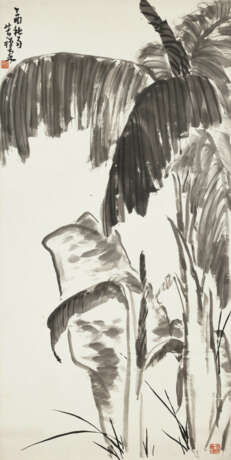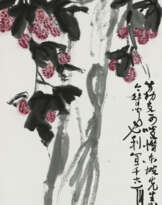ID 966256
Lot 1204 | LI KUCHAN (1899-1983)
Estimate value
HKD 50 000 – 80 000
Plantain and Rock
Scroll, mounted and framed, ink on paper
138.5 x 70.5 cm. (54 ½ x 27 ¾ in.)
Inscribed and signed, with one seal of the artist
Dated autumn, dingyou year (1957)
Post lot text
The famed Indian painter Beohar Rammanohar Sinha, who illuminated the original Constitution of India and frescoed Martyr-Memorial Concert Hall, lived in different parts of China between 1957-59 as a scholar but also as India’s cultural emissary. The objective was to forge a robust cross-cultural bridge between two great civilisations through fine arts. While promoting Indian art in China, Rammanohar gained expertise and collected works in Chinese painting and lacquer-work from great contemporary masters firsthand, such as Qi Baishi (1864-1957) and his contemporaries and followers Chen Banding (1877-1970), Wu Zuoren (1908-1997), Luo Ming (1912-1998), and Li Keran (1907-1989). Part of the collection was sold at Christie’s in Autumn 2017 (Lots 1295-1299).
In 1957, Rammanohar met Li Kuchan at the introduction of Qi Baishi. The two shared studio space in Beijing for months. During this period, Rammanohar taught the techniques and elements unique to Indian painting to Central Academy of Fine Arts students. In turn, he witnessed the nuanced, expressive skills to depict the forms and movements of birds and flowers from Li Kuchan. Some of his Li Kuchan paintings were sold at Christie’s Spring 2021 auctions (Lots 1119-1123).
The present selection includes four works by Li Kuchan. Another works by Li Kuchan and Rammanohar will be offered in Exquisite Eye: Chinese Paintings Online.
| Artist: | Li Kuchan (1898-1983) |
|---|---|
| Art style: | Modern art |
| Artist: | Li Kuchan (1898-1983) |
|---|---|
| Art style: | Modern art |
| Address of auction |
CHRISTIE'S 18 Chater Road Central Hong Kong Hong Kong | ||||||||||||||
|---|---|---|---|---|---|---|---|---|---|---|---|---|---|---|---|
| Preview |
| ||||||||||||||
| Phone | +85227601766 | ||||||||||||||
| Fax | +852 2760 1767 | ||||||||||||||
| Conditions of purchase | Conditions of purchase | ||||||||||||||
| Business hours | Business hours
|











